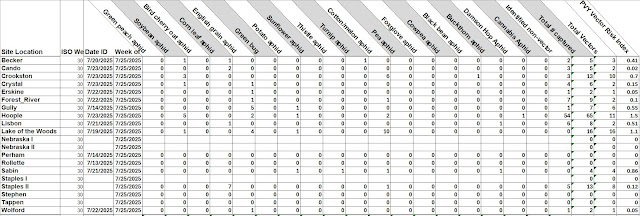Trap Catches to September 12, 2025.
With vine killing occurring throughout the region, only 8 traps reported this week. Average numbers per trap were well down (~1/3 of the last trapping period); it seems the September population crash is underway. While most species were represented across the region, average capture of all species was down. Vector species were still recovered however.
Green peach aphid was recovered at one location, soybean and buckthorn aphids were the most numerous species recovered across the region. Several other species were present at various locations. The colder nights are, however, likely decreasing activity and numbers are anticipated to decrease through the next couple of weeks.
Have a great week, and hope your harvest is going well!
PVY Vector Risk Index - The ability of an aphid to transmit a virus is referred to as its vector efficiency, these values can be compared across species as a relative efficiency factor (also called the REF). Because data indicate it is the most efficient aphid species in transmitting PVY, green peach aphid's REF is set as 1, with other species' REF being calculated on their comparison to green peach aphid. E.g. soybean aphid has been found to be approximately 10% as efficient at transmitting PVY as is green peach aphid, so soybean aphid is assigned a REF of 0.1. The PVY Vector Risk Index is a reflection of the comparative ability of the different aphid species to transmit PVY to plants. By multiplying the number of a species caught by its REF, we can estimate the risk from the total vectors captured, adjusted by the ability to transmit virus.
The usual reminders:
- keep scouting; aphids can establish early after potatoes are up. Field scouting is less effective at finding aphid vector species that don't colonize potatoes. While these species will enter potato fields and probe plants, they can't survive on potatoes, consequently they'll keep moving through the field, sampling additional plants and spreading inoculum in the field. Remember to check predictive sites like this one and University of Wisconsin's weather based Vegetable Disease & Insect Forecasting site,(https://agweather.cals.wisc.edu/vdifn) which uses current weather data and historical populations as a predictor of current aphid vector populations. These will give you a better idea of the potential presence of non-colonizing aphids.
- the research literature reports that the use of crop oils is the most consistent post-planting technique in preventing transmission of PVY and it can be improved with the addition of the insecticide Lambda-Cyhalothrin.
- most of the research indicates that insecticides on their own are usually not effective enough at suppressing PVY transmission, but are still very useful parts of your management program. Treating fields with one of the anti-feeding insecticides (e.g. Sivanto Prime, Sefina, Transform, Fulfill or Beleaf) to control colonizing aphids, such as green peach, potato, or cotton melon aphids, can be beneficial in decreasing movement of PVY inoculum within fields
- aphids preferentially first colonize fields at the edge. Using border crops in the headlands may decrease aphid colonization. But if using a border crop, it's a good idea to use treated seed to prevent the development of potential vector species in that border. Also, include those border crops when treating the field for colonizing aphids!
Happy scouting and have a great weekend!
Green peach aphid was recovered at one location, soybean and buckthorn aphids were the most numerous species recovered across the region. Several other species were present at various locations. The colder nights are, however, likely decreasing activity and numbers are anticipated to decrease through the next couple of weeks.
Have a great week, and hope your harvest is going well!
The usual reminders:
- keep scouting; aphids can establish early after potatoes are up. Field scouting is less effective at finding aphid vector species that don't colonize potatoes. While these species will enter potato fields and probe plants, they can't survive on potatoes, consequently they'll keep moving through the field, sampling additional plants and spreading inoculum in the field. Remember to check predictive sites like this one and University of Wisconsin's weather based Vegetable Disease & Insect Forecasting site,(https://agweather.cals.wisc.edu/vdifn) which uses current weather data and historical populations as a predictor of current aphid vector populations. These will give you a better idea of the potential presence of non-colonizing aphids.
- the research literature reports that the use of crop oils is the most consistent post-planting technique in preventing transmission of PVY and it can be improved with the addition of the insecticide Lambda-Cyhalothrin.
- most of the research indicates that insecticides on their own are usually not effective enough at suppressing PVY transmission, but are still very useful parts of your management program. Treating fields with one of the anti-feeding insecticides (e.g. Sivanto Prime, Sefina, Transform, Fulfill or Beleaf) to control colonizing aphids, such as green peach, potato, or cotton melon aphids, can be beneficial in decreasing movement of PVY inoculum within fields
- aphids preferentially first colonize fields at the edge. Using border crops in the headlands may decrease aphid colonization. But if using a border crop, it's a good idea to use treated seed to prevent the development of potential vector species in that border. Also, include those border crops when treating the field for colonizing aphids!
Happy scouting and have a great weekend!
Click on any image below for larger-scale version.






































